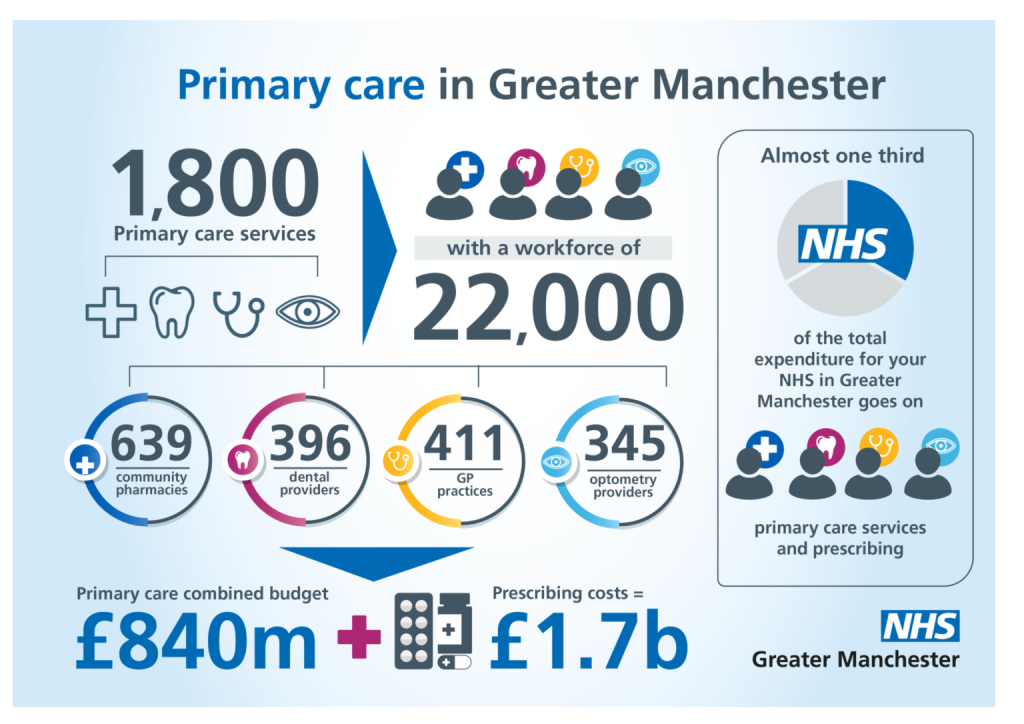The total number of job adverts for general practitioners was more than twice the national average in Greater Manchester last year, according to new data from the ONS.
The region saw a total of 120 live online job ads for GPs per 100 working-age people, the second highest in the country, and more than double the national average of 56.4.
Though the national picture of primary care services is widely considered to be in crisis, the figures suggest that the situation for residents of Greater Manchester is improving faster than many other areas of the country.
An NHS Digital report on GP workforce released in October showed that the total number of GPs in Greater Manchester rose by 43.8% from 2016 to 2024, despite figures across the country seeing a meagre 16.9% rise in the same period.
The health of the NHS
This data comes in the wake of a landmark report from Lord Darzi, investigating the state of the NHS in England.
The Darzi report, released in September this year, was the result of an independent investigation into the performance of the NHS, including patient access and quality of care.
In an open letter to the Secretary of State for Health and Social Care, Lord Darzi said: “Although I have worked in the NHS for more than 30 years, I have been shocked by what I have found during this investigation.”
Among his findings, Lord Darzi's report raised concerns about the sustainability of general practice across the country.
“GPs are seeing more patients than ever before, but with the number of fully qualified GPs relative to the population falling, waiting times are rising and patient satisfaction is at its lowest ever level.
“There are huge and unwarranted variations in the number of patients per GP, and shortages are particularly acute in deprived communities.”
A postcode lottery
The nationwide disparity in GP-to-patient ratios is echoed across Greater Manchester, with the most recent data showing Oldham as the borough with the fewest GPs per 100,000 patients, and Stockport with the most - 69.4 and 95.8 respectively.
Oldham Council’s cabinet member for Adults, Health and Wellbeing, Barbara Brownridge, says that healthcare is a complex picture, and the numbers don’t tell the whole story.
“Despite the national picture, we have retained the same number of GPs in Oldham, and they are delivering more appointments than ever. That’s a result of a constructive dialogue around primary care between the council, health and social care services and the voluntary sector.
“I wouldn’t want to single out any particular organisation because it’s down to the coordinated approach of the ICP system, bringing GPs and pharmacists and community services together to reduce the demand on the health service.”
Cllr Brownridge stressed the need for combined health and social care access for patients, recognising that the support people need can have multiple causes.
“When people go to the GP it’s not always because of a medical problem - it can be rooted in financial worries or problems with housing. It’s true that the general health and wellbeing of the population in Oldham is not good, but we’re doing great things in the area to help people access the care they need.”
The reality for GPs
With growing patient numbers nationwide, the pressure on GPs shows no sign of abating, a concern that the Royal College of GPs (RCGP) says cannot be ignored.
RCGP Chair Professor Kamila Hawthorne said: “We need action now to alleviate the workforce crisis. This means urgent investment in general practice, including into schemes to recruit and retain the GPs we need, to allow us to continue to provide the high-quality care our patients deserve.”
Hawthorne added that the inequality in access to care across the country is only serving to increase the burden on GPs.
She said: “It shouldn’t be the case that a GP in one area of the country is responsible for nearly twice as many patients than in another – or that a patient’s access to care is determined by where they live.
“We would argue that almost all areas are under-doctored – but as ever, it’s the most deprived areas, and often our most vulnerable patients, that are bearing the brunt.”
What is Greater Manchester doing differently?
Despite the previous government's promises to increase the GP workforce by recruiting 5,000 more full-time GPs by 2020/21, the RCGP reported that there are now almost 100 fewer fully qualified, full-time-equivalent GPs than in 2019.
The Darzi report showed that less than 10% of the total NHS budget in England goes to primary care, a figure that has been falling despite an ever-growing workload, but one that is being challenged in Greater Manchester.
The Greater Manchester Primary Care Blueprint - a five-year plan for the delivery of primary care in the region - shows that almost a third of the combined authority's NHS budget is being spent on primary care services and prescribing.

Though in areas like Oldham the council's focus is on GP retention, a report released in GMCA labour market report for autumn 2024 showed that 7% of healthcare positions in Greater Manchester are vacant, meaning recruitment across the sector remains a priority.
The health and social care sector accounts for one in six of the working population in Greater Manchester, the largest single workforce in the region, employing more than 200,000 workers, while the wider public sector employs around one in three workers, an above-average proportion compared to other regions of England.
Though the rate of job ads for GPs suggests positive action by local authorities in Greater Manchester to improve healthcare access for the region's 3.3m registered patients, it could simply be part of a wider trend for job adverts targeting workers in this area.
Data released by the Office for National Statistics (ONS) in October shows higher volumes of job adverts across all industries in Greater Manchester, consistently rating higher in total ad volume than the UK average since June 2017, perhaps proving that the dominant factor is the region's enduring appeal in the eyes of online advertisers.
Featured image: Unsplash




